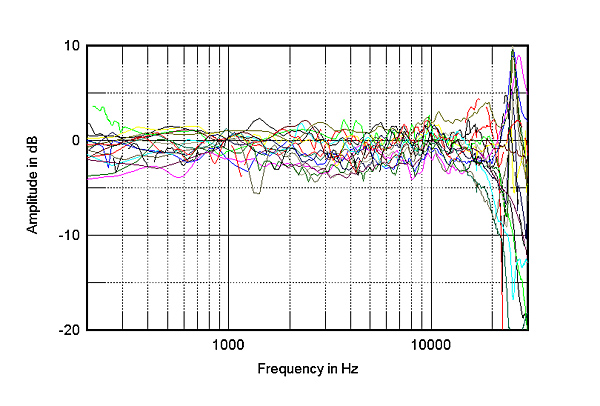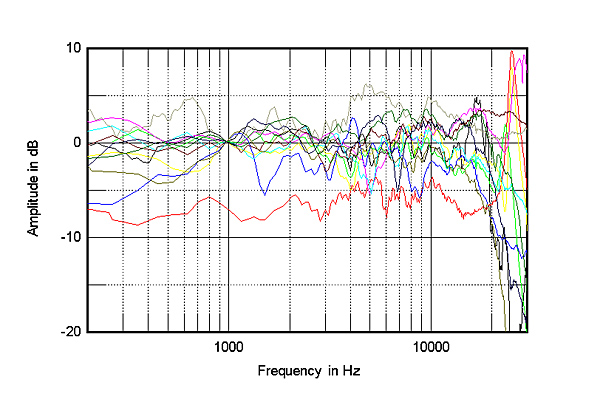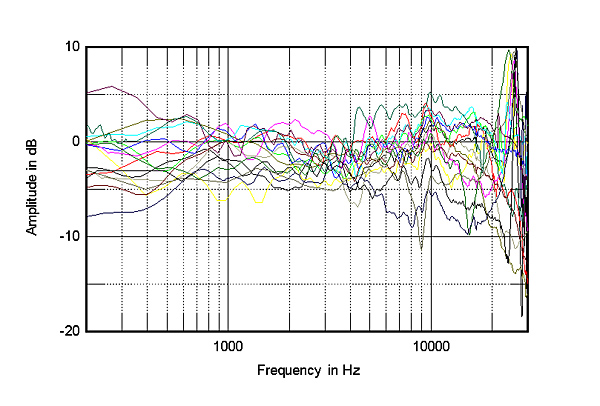| Columns Retired Columns & Blogs |
Interesting ...... Only 3 loudspeakers in that list made it to Class-A rating :-) .......
I know what you're about say: If I've gone to all this trouble, doesn't this imply that Stereophile feels flatness of frequency response to be the primary deciding factor in determining a speaker's quality?
The short answer to that question is an emphatic "No!"
The long answer is that while it's important for a speaker to be flat on-axis—or assessed across a 30° window, as I prefer to do—such flatness of response is only one of several factors that contribute to overall perceived quality. Among the more important parameters are: low-frequency definition and extension; whether the overall response tilts up or down; the overall smoothness of the response trend through the midrange and treble; the absence or presence of strong resonances in the midrange and low treble; the evenness of high-frequency dispersion in both horizontal and lateral planes; the stability and precision of lateral stereo imaging at different frequencies; the degree to which the speaker can preserve and reproduce the depth information encoded within recordings; the lack or presence of signal compression at high playback levels; the presence of distortion in the bass (common but subjectively innocuous); and distortion in the midrange (rare but subjectively a no-no). I have therefore attached a commentary to many of the curves so that you're not led into error.
In addition, if this "Follow-Up" stimulates your buying juices, you must read the original reviews, which is where the full description of what each speaker does right and wrong is to be found. If you're not prepared to do that, then I forbid you to read further.

Fig.3: The speakers in this group are all superbly flat; in fact, the frequency-weighted standard deviation of the top nine models is lower than that of our B&K microphone. The champion when it comes to midrange and treble flatness is the little JBL XPL-90. Despite this superb behavior, it was downrated on auditioning for three main reasons: its bass was underdamped and ill-defined; it was very beamy in its top octave, meaning that its room sound lacked "air"; and the slight rises in the upper midrange were due to resonances that lent its on-axis sound somewhat of a peaky nature.
The almost-as-flat Meridian D6000 is so far unique in using digital signal processing (DSP) to implement both its crossover filters and a degree of equalization. Though a "Follow-Up" review is planned, I've included Sam Tellig's darling, the Spendor S100, which can be seen to be superbly flat. The Snell C/IV was downrated on auditioning due to a soundstage presentation that lacked depth, while the Avalon Eclipse sounded brighter than its on-axis response would suggest, perhaps due to its wide dispersion in the lower treble rendering the room reverberant field too energetic in this region. Its dynamic range was also somewhat limited for such an expensive speaker.
Though Wharfedale's diminutive Diamond IV does well on the standard deviation of its departure from perfect, its main error, the broad peak at the top of the woofer range, is very audible as an added nasality to the sound. This is also the case with Dick Olsher's Black Dahlia DIY design. Dick himself liked the JM Lab Micron with the inverted titanium-dome tweeter a lot, presumably because its response, though rough, is evenly balanced. The Genesis IM-5200 reviewed by TJN in this issue is commendably smooth but offers a slight rising trend from the bottom of the midrange to the top of the treble, which doubtless contributed his description of its sound as "crisp."

Fig.4: The members of this second group have nearly all been recommended by Stereophile, their slightly greater departures from flat compared with the first group being compensated for by virtues elsewhere. As with the Diamond and Black Dahlia above, though the revised TARA Labs Timekeeper 0.5 is flat overall, its one departure is so gross that the listener cannot escape it. Likewise, while the inexpensive B&W may have had a basically flat response over much of its range, it failed to impress Stereophile's listening panel due to high levels of resonant coloration and a somewhat peaky treble, the latter noticeable on its response curve and rendered more audible than might be expected in absolute terms by a lack of energy immediately below. By contrast, the Nestorovic's peaky treble seems to be compensated for by a generally exaggerated but well-defined bass region.
The Infinity Modulus response shown was taken without its subwoofer; the response can be seen to roll out very early in the upper bass, leading to a very lightweight balance. Otherwise flat, it was downgraded subjectively due to a lack of presence to its sound, which may be connected with the slight suckout at crossover. The revised Dahlquist DQ12 did a lot better than the earlier version in fig.7, due to its better-balanced treble, but many audiophiles will find its exaggerated bass too rich. The Triad System Seven satellites are basically flat but roll out a little too early in the lower midrange to form a good match with the subwoofer.

Fig.5: Again, most of the speakers in this group have been recommended by Stereophile, such exceptions as the MB Quart 490 and AR Spirit being due to a somewhat over-lumpy balance. (The AR needs boundary reinforcement to bring its lower mids and bass in line with the rest of its response.) In general, however, these models show either more unevenness to their midrange/treble balance, slightly sloping balances, or exaggerated levels at the edges of the band, compared with the speakers in the first two groups.
Though more expensive than the almost identical Ensemble PA1 (fig.4), our Ensemble Reference sample measured as being somewhat less smooth, perhaps due to the fact that the PA1 had been thoroughly broken in while the Reference was measured out of the box. The TDL Reference Standard shows a smooth response trend through the mids and highs, but failed to get a recommendation due to its exaggerated and colored bass region.
Unlike most speakers, the response shown for the B&W Matrix 800 that so impressed Lewis Lipnick last June is not averaged across a 30° window but was taken on the midrange axis, which proved to be where the sound was most neutral. We are expecting a set of these 240lb behemoths to arrive in Santa Fe, where I can do some more thorough measurements than were possible in LL's small listening room. (In general, the closer the walls, the less accurate MLSSA measurements will be in the midrange.)

Interesting ...... Only 3 loudspeakers in that list made it to Class-A rating :-) .......

A few thoughts along what you've already written:
• The two biggest areas where subjectivist reviewers and their advocates go wrong is in making the proclamation that measurements give no information on how the product sounds. I think you have shown that to be wrong over the years.
• While everything you can measure can be heard (given the criterion and the method used), everything you can hear still can't be measured. That being said, the measurements and the systems used to make them offer a lot of insight into the item being put under scrutiny.
• The human senses are not perfect and neither are our memories of our sensorial experiences. While the test equipment John uses is not perfect, as long as it operates correctly it has no problem with flared up sinuses, migraines, tinnitus or any other factor that can effect human hearing on a daily basis.
• The sound of your room is just as important as the sound from your speakers. It's also easier & cheaper to improve your room sound and it can be done in stages to great effect rather than wholesale.
• Test equipment is a lot like a car: the most important part is the nut behind the wheel
Keep up the good work, you crazy guy!

Careful design is the most important aspect of product.
The "nut behind the wheel" might be a worst case scenario.
Every product is carefully scrutinized & measured, built with tolerances +/-, evaluated in laboratory settings, durability tested, production qualified, priced, packaged, weighed and compared with all known competitors.
Some folks might be "nuts behind the keyboard" but our JA isn't one of them.
Tony in Nevada

... listening to and, more importantly, enjoying music - rather than focusing on equipment - one could have done so much worse than to have chosen the Spendor S100.

There is a current version of Spendor Classic 100 :-) ..........

[[Redacted.]] :-)

John,
I don't know what your motivations were in posting this here, but it doesn't matter: I'm not going to allow Aczel's libels to be reposted on Stereophile's own website.
If anyone doubts JA's seriousness or significance to audio, I'll refer them to the Audio Engineering Society, which honored him with their Heyser award, which is a big deal.
Jim Austin, Editor
Stereophile